L. Venkatakrishna Iyer | |
|---|---|
| Born | India |
| Died | India |
| Occupation | Civil engineer |
| Known for | Polavaram Project |
| Awards | Padma Bhushan |
L. Venkatakrishna Iyer was an Indian civil engineer and the Chief Engineer of the Public Works Department of the State of Tamil Nadu. [1] It was Iyer who did the survey and submitted the initial proposal for building a reservoir across Godavari River near Polavaram in 1941 which was later commissioned as Polavaram Project. [2] An alumnus of the Town Higher Secondary School, Kumbakonam, [3] he was among the few who assisted Chinnaswami Rajam in founding Madras Institute of Technology (MIT) and sat on the core committee which oversaw the establishment of the institution. [4] The Government of India awarded him the third highest civilian honour of the Padma Bhushan, in 1961, for his contributions to society. [5]

The Godavari is India's second longest river after the Ganga River and drains the third largest basin in India, covering about 10% of India's total geographical area. Its source is in Trimbakeshwar, Nashik, Maharashtra. It flows east for 1,465 kilometres (910 mi), draining the states of Maharashtra (48.6%), Telangana (18.8%), Andhra Pradesh (4.5%), Chhattisgarh (10.9%) and Odisha (5.7%). The river ultimately empties into the Bay of Bengal through an extensive network of distributaries. Measuring up to 312,812 km2 (120,777 sq mi), it forms one of the largest river basins in the Indian subcontinent, with only the Ganga and Indus rivers having a larger drainage basin. In terms of length, catchment area and discharge, the Godavari is the largest in peninsular India, and had been dubbed as the Dakshina Ganga.

Madras Institute of Technology (MIT) is an engineering institute located in Chromepet, Chennai, India. It is one of the four autonomous constituent colleges of Anna University. It was established in 1949 by Chinnaswami Rajam as the first self-financing engineering institute in the country and later merged with Anna University. The institute was among the first educational institutions in India to offer new areas of specialization, such as aeronautical engineering, automobile engineering, electronics engineering and instrumentation technology. Madras Institute of Technology (MIT) was the first self-financing institute opened in India.

Anna University is a public state university located in Chennai, Tamil Nadu, India. The main campus is in Guindy. It was originally established on 4 September 1978 and is named after C. N. Annadurai, the former Chief Minister of Tamil Nadu.
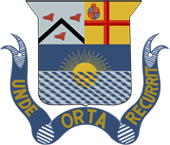
Presidency College is an art, commerce, and science college in the city of Chennai in Tamil Nadu, India. On 16 October 1840, this school was established as the Madras Preparatory School before being repurposed as a high school, and then a graduate college. The Presidency College is one of the oldest government arts colleges in India. It is one of two Presidency Colleges established by the British in India, the other being the Presidency College, Kolkata.

Rajahmundry, officially Rajamahendravaram, is a city in the Indian state of Andhra Pradesh and district headquarters of East Godavari district. It is the seventh most populated city in the state. During British rule, the district of Rajahmundry was created in the Madras Presidency in 1823. It was reorganised in 1859 and bifurcated into the Godavari and Krishna districts. Rajahmundry was the headquarters of Godavari district, which was further bifurcated into East Godavari and West Godavari districts in 1925. It is administered under Rajahmundry revenue division of the East Godavari district. The city is known for its floriculture, history, culture, agriculture, economy, tourism, and its heritage. It is known as the "Cultural Capital of Andhra Pradesh".
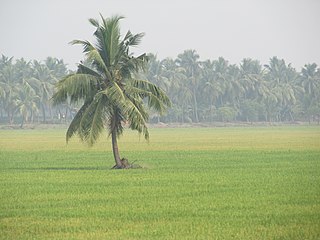
The West Godavari district is a coastal district in the Indian state of Andhra Pradesh with an administrative headquarters in Bhimavaram. As of the 2011 Census of India, the district has an area of 2,178 km2 (841 sq mi) and a population of 1,779,935. It is bounded by the Krishna district and Bay of Bengal to the south, East Godavari district to the east, and Eluru district, Kolleru Lake and Upputeru Drain to the northwest.

Ariyakudi Ramanuja Iyengar, popularly known as Ariyakudi, was a Carnatic music vocalist, born in Ariyakudi, a town in the present-day Sivaganga district of Tamil Nadu. Ariyakudi developed a unique style of singing which came to be known as The Ariyakudi Tradition and is followed by his students. He is credited with establishing the modern katcheri (concert) traditions in Carnatic music.
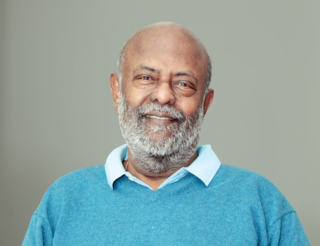
Shiv Nadar is an Indian billionaire businessman and philanthropist. He was the founder and chairman of HCL Technologies, and is chairman of the Shiv Nadar Foundation. Nadar founded HCL in the mid-1970s and transformed the IT hardware company into an IT enterprise over the next three decades. In 2008, Nadar was awarded Padma Bhushan for his efforts in the IT industry. Nadar, nicknamed by friends as Magus, since the mid-1990s he has focused his efforts on developing the educational system of India through the Shiv Nadar Foundation. According to Forbes, He is the 3rd richest person in India and the 30th richest person in the world with an estimated net worth of US$40 billion as of February 2024.

Town Higher Secondary School is a school in Kumbakonam, a town in the Thanjavur district in the Indian state of Tamil Nadu.
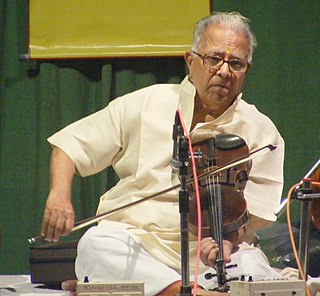
Trippunithura Narayana Krishnan was an Indian Carnatic music violinist. Along with Lalgudi Jayaraman and M. S. Gopalakrishnan he was considered part of the violin-trinity of Carnatic music. He was awarded the Madras Music Academy's Sangeetha Kalanidhi in 1980. He was also the recipient of the Padma Bhushan, India's third highest civilian honour, in 1992, and earlier, the Padma Shri, India's fourth highest civilian honour, in 1973.
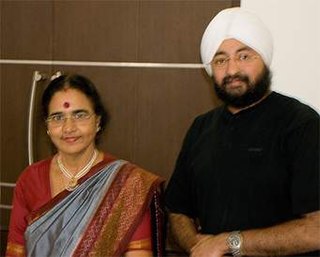
N. Rajam is an Indian violinist who performs Hindustani classical music. She remained professor of music at Banaras Hindu University, eventually became head of the department and the dean of the Faculty of Performing Arts of the university.

The Polavaram Project is an under construction multi-purpose irrigation project on the Godavari River in the Eluru District and East Godavari District in Andhra Pradesh. The project has been accorded National project status by the Central Government of India. Its reservoir back water spreads up to the Dummugudem Anicut and approx 115 km on Sabari River side. Thus back water spreads into parts of Chhattisgarh and Odisha States. It gives major boost to tourism sector in Godavari Districts as the reservoir covers the famous Papikonda National Park, Polavaram hydro electric project (HEP) and National Waterway 4 are under construction on left side of the river. It is located 40 km to the upstream of Sir Arthur Cotton Barrage in Rajamahendravaram City and 25 km from Rajahmundry Airport.
Balasubramaniam Rajam Iyer was a Carnatic singer from South India. He was awarded the Madras Music Academy's Sangeetha Kalanidhi in 1987.
Arcot Ramachandran (1923-2018) was an Indian scientist, anthropologist, author and a former Under-Secretary General of United Nations Centre for Human Settlements, known for his scholarship on the subjects of heat and mass transfer and environment and his social commitment to the cause of sustainable development. The Government of India honoured him in 2003, with the Padma Bhushan, the third highest civilian award, for his services to the fields of Science and Engineering.

Munirathna Anandakrishnan was an Indian civil engineer, educationist, a chairman of the Indian Institute of Technology, Kanpur and a vice-chancellor of Anna University. He was also an Advisor to the Government of Tamil Nadu on Information Technology and e-Governance. A winner of the National Order of Scientific Merit (Brazil), he was honored by the Government of India, in 2002, with Padma Shri, the fourth highest Indian civilian award.
Anna Rajam Malhotra was an Indian Administrative Service officer. She was the first woman in India to hold this position. Anna Rajam belonged to the 1951 batch of the IAS and married R. N. Malhotra, her batchmate.
Krishnaswami Srinivas Sanjivi (1903–1994) was an Indian medical doctor, Gandhian, social worker and the founder of Voluntary Health Services (VHS), a medical facility in Chennai reported to be serving the lower and middle-class people of the society. He was honoured by the Government of India in 1971 with Padma Shri, the fourth highest Indian civilian award. Five years later, the government followed it up by awarding him the third highest civilian award of Padma Bhushan in 1976.

Chinnaswami Rajam was a pioneering entrepreneur, eminent industrialist, and the founder of the present Madras Institute of Technology of the Anna University, Chennai. The late Dr. C. P. Ramaswami Iyer called him a "pioneer in the industrial field".

Vaidyeswaran Rajaraman is an Indian engineer, academic and writer, known for his pioneering efforts in the field of Computer Science Education in India. He is credited with the establishment of the first academic program in computer science in India, which he helped initiate at the Indian Institute of Technology, Kanpur in 1965. An elected fellow of all the Indian science academies, he is a recipient of Shanti Swarup Bhatnagar Prize, the highest Indian award in Science and Technology category for young scientists and several other honors including Om Prakash Bhasin Award and Homi Bhabha Prize. The Government of India awarded him the third highest civilian honor of the Padma Bhushan, in 1998, for his contributions to science.
N. Srinivasa Iyer Ramaswamy (1926–2012), popularly known as Cartman Ramaswamy, was an Indian engineer, educationist, management academic and writer, and the founder director of the Indian Institute of Management, Bangalore. He was the founder of Centre for Action, Research and Technology for Man, Animal and Nature (CARTMAN), a non governmental organization working for region-relevant and appropriate technology transfer to rural areas and Indian Heritage Academy, an organization involved in propagating Indian cultural traditions. He was also the founder chairman of the Adarsh Vidya Kendra (AVK) Group of educational institutions. The Government of India awarded him the third highest civilian honour of the Padma Bhushan, in 2006, for his contributions to society.